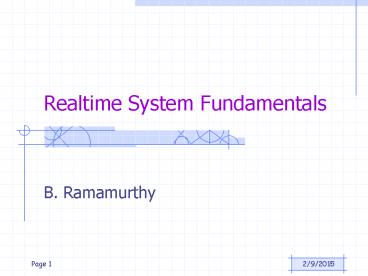Realtime System Fundamentals - PowerPoint PPT Presentation
Title:
Realtime System Fundamentals
Description:
We will have it installed on Linux machines at 206 Franzack. And on a Linux laptop. You can use this to compile the software you write for shell and drivers and ... – PowerPoint PPT presentation
Number of Views:29
Avg rating:3.0/5.0
Title: Realtime System Fundamentals
1
Realtime System Fundamentals
- B. Ramamurthy
2
Review of Project Plans
- Hardware modifications (proof of concept done)
- Software to generate xinu.boot
- Cross compiler (host system to MIPS)
- gcc is now available at /projects/bina/NEXOS/CSE32
1 - We will have it installed on Linux machines at
206 Franzack - And on a Linux laptop
- You can use this to compile the software you
write for shell and drivers and anything else you
add to exinu. - Uploading xinu.boot to test your shell and
drivers - You can do it from any system with a serial port
, hyperterminal and tftp installed. Such a setup
will be available in the Franzack lab and is
currently available during recitation/lecture on
Tuesdays at 340 Bell.
3
Realtime scheduling
- We discussed realtime system scheduling
- Earliest deadline scheduling (EDS)
- Starting deadline
- Completion deadline
- Dynamic priority scheduling
- Rate monotonic scheduling (RMS)
- Periodic tasks are prioritized by the frequency
of repetition (high priority to tasks with
shorter periods) - Preemptive scheduling
- Fixed priority scheduling
- See table 3.3
- Schedulability according to RMS
- S(Ci/Ti) lt n(21/n-1)
- Cyclic executives (pre-scheduled)
- Concepts of hyper-period and frame
- Hyper-period is a the repeated loop
- Pages 92-93
- Exercises 3.13 3.17
4
Intertask communication and synchronization
- Buffering data
- For inter-task communication
- For sending data
- To handle incompatibilities between tasks
typically a buffer is introduced - Classical buffer (fig. 2.11)
- Double buffer (fig. 2.12)
- Ring buffer (fig. 2.13)
- Mail boxes
5
Mailboxes
- Mailboxes are intertask communication device
available in many commercial operating systems. - A mailbox is a memory location that one or more
tasks can use to pass data or for
synchronization. - post and pend are used for mailbox write and read
6
Mailbox implementation
- List of tasks and needed resources (mailboxes,
printers etc.) is kept along with a second table
of list of resources and their state (tables 3.6,
and 3.7)
taskID Resource Status
100 printer Has it
102 Mailbox 1 Has it
104 Mailbox 2 pending
resource status owner
printer busy 100
Mailbox 1 busy 102
Mailbox 2 empty none
7
Mailbox implementation (contd)
- Task 104 requests mailbox 2 pend or read
- It blocks waiting for read.
- Operating system checks task table, if key is
full or available for mailbox 2, then it unblocks
Task 104 and lets it read from mailbox 2 - Task 104 reads from mailbox 2 and set it key
back to empty. - Accept is another function for mailbox it is a
non-blocking call it reads data if available or
it fails
8
Task states
- Ready, running and blocked
- Critical regions
- Semaphores for protection of critical regions
- Identify the critical region and enclose it with
p() and v() operators of the semaphore - Lets look at an example of implementation of
mailboxes using semaphores
9
Mailboxes using semaphores
- Semaphore mutex, proc_sem
- Bool full, empty
- void post(int mailbox, int message)
- wait(mutex)
- if (empty_slots)
- insert(mailbox, message)
- update
- signal(mutex)
- signal(proc_sem)
- else // no empty slots wait for empty slots
- signal(mutex)
- wait(proc_sem)
- wait(mutex)
- insert(mailbox,message)
- update()
- signal(mutex)
- signal(proc_sem)
10
Mailboxes using semaphores
- void pend(int mailbox, int message)
- wait(mutex)
- if (full_slots)
- extract(mailbox, message)
- update()
- signal(mutex)
- else
- ..
- signal(mutex)
- wait(proc_sem)
- wait(mutex)
- extract(mailbox,message)
- update()
- signal(mutex)
11
Priority Inversion
- When we allow concurrent task to execute and with
semaphore and mailboxes and other synchronization
primitives, it is possible that a low priority
taks may come to block a high priority task. This
situation is known as priority inversion. - See fig.3.16































